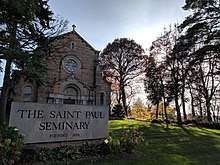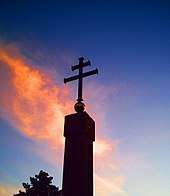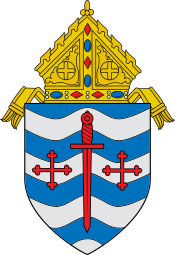Saint Paul Seminary School of Divinity
 St. Mary's Chapel | |
| Motto | Pastores Dabo Vobis |
|---|---|
Motto in English | I will give you shepherds |
| Type | Major Seminary |
| Established | 1894 |
| Affiliation | Roman Catholic |
| Endowment | $25,106,689[1] |
| Budget | $6,389,498[2] |
| President | Archbishop Bernard Hebda |
| Rector | Bishop Andrew Cozzens (Interim) |
| Dean | Dr. Kenneth Snyder |
Academic staff | 22 |
Administrative staff | 27 |
| Students | 85 seminarians, 62 lay, 600 Catechetical Institute[2] |
| Location | St. Paul, Minnesota, United States of America |
| Vice-rectors | Rev. Scott Carl, Rev. Juan Miguel Betancourt |
| Colors | Gold and Black |
| Athletics | Sons of Thunder |
| Nickname | SPS |
| Affiliations | ATS |
| Website | http://www.stthomas.edu/spssod/ |
| Board of Trustees | |
| Members | Visit seminary website |
|---|---|
The Saint Paul Seminary School of Divinity, located in Saint Paul, in the U.S. state of Minnesota, was founded by Archbishop John Ireland in 1894, to provide ordained priests for the ever-increasing Catholic population of the Upper Midwest. The seminary now sits on the south campus of the University of St. Thomas, allowing the seminarians and lay students to be part of the St. Thomas community. Since its creation, over 3,000 priests have been ordained from The Saint Paul Seminary, with thirty-three of them being consecrated bishops — including three archbishops, one of whom, Archbishop Fulton J. Sheen, is a candidate for canonization.
As of the 2018-2019 academic year, there are 85 seminarians representing 16 dioceses and religious communities in formation at The Saint Paul Seminary; 31 men were in formation for the permanent diaconate; and 62 lay students were enrolled in the School of Divinity's graduate degree programs. In addition, more than 600 students were enrolled in the Archbishop Harry J. Flynn Catechetical Institute, a two-year, non-degree faith formation program.
The affiliated college seminary, St. John Vianney Seminary, is on the other side of the University of St. Thomas campus.
History
Early history

The primary financier to bring about Ireland's vision was James J. Hill, a Methodist and the president of the Great Northern Railway. Despite being Protestant, Hill's wife, Mary, was a devout Roman Catholic and the half-million-dollar gift and endowment to start the seminary were in honor of her. Being overly dedicated to even the smallest aspects of the new seminary project, Hill's influence over the completed project could be seen on a larger scale in that the six initial buildings were made to look like a train depot (the seminary administration building), a steam engine (gymnasium and physical plant), box cars (Cretin, Grace (though constructed in 1913), and Loras halls), a refectory, and a roundhouse (school building). The seminary complex was designed by architect Cass Gilbert, who also designed the Minnesota State Capitol. When the seminary was finally completed, Archbishop John Ireland shared his inspiration and desires for the new seminary in his address at the seminary's dedication on September 4, 1895 saying,
May rich blessings come to the Northwest from The Saint Paul Seminary! The influence radiating from the seminary will reach more immediately the people of its own religious faith. They are a large part of the general population of the Northwest. Beyond them, however, must its influence go. Its spirit will be to work for the whole people, offering its strength to uphold every noble cause, and willing to cooperate with all men who labor to serve God, humanity, and country.[3]
The dedication was attended by apostolic delegate Archbishop Francesco Satolli, four other archbishops, ten bishops, and over four hundred priests. The Pontifical Mass celebrated to dedicated the new seminary was attended by 20,000 people all told. Initially, in 1894, the seminary had sixty-five seminarians, by 1900 there were a hundred and ten seminarians from all over the Midwest and even from as far away as San Francisco. With the seminary buildings completed and students arriving, Archbishop John Ireland began the second phase of his building plans, the erection of what was to become the main chapel, St. Mary's Chapel.[4]
The seminary's old dormitory row (Loras, Cretin, and Grace halls) was nominated to the National Register of Historic Places in 1986 as a historic district. The St. Paul Seminary Historic District received reference number #86003818 and the listing code DR, meaning "Date Received" and nomination pending, but the listing was never finalized.[5]
Contemporary history
In 1987 The Saint Paul Seminary and the then College of St. Thomas, under the supervision of the Roman Catholic Archdiocese of Saint Paul and Minneapolis, formalized ties and the seminary became The Saint Paul Seminary School of Divinity. This affiliation agreement has allowed the seminary to expand its programs to support both the formation of seminarians to become priests and the laity to become leaders in their parishes. Students of The Saint Paul Seminary School of Divinity can earn degrees in Masters of Arts in Theology, Masters of Arts in Religious Education, Master of Divinity, and Masters of Arts in Pastoral Ministry. While the two institutions are affiliated, they are still separate corporations with separate boards of directors, finances, and staff.
Upon the signing of the affiliation agreement, the seminary built new administration and dormitory buildings and sold the most of its land and buildings to the university, including Loras, Grace, and Cretin residence halls and the Binz refectory. The Ireland library building was included in the sale, but the books remain the property of the seminary. St. Mary's Chapel was also renovated at that time; the new administration building was built to connect to the former front of the chapel, which is now the rear.
In 2005, Msgr. Aloysius R. Callaghan was appointed as the rector of the seminary. A priest of the Diocese of Allentown, Pennsylvania, he worked as a canon lawyer for many years in both the Vatican and in the Archdiocese for the Military Services. During his tenure as seminary rector, the seminary greatly increased its enrollment and programs. In 2018, Msgr. Callaghan transitioned to Rector Emeritus. On July 16, 2018, it was announced that Fr. Joseph Taphorn will succeed Msgr. Callaghan starting January 1, 2019.[6] During the interim time period, Bishop Andrew Cozzens is the interim rector.
Campus
Academic buildings
The Archbishop Ireland Memorial Library is the theological library of the seminary; there are over 110,000 volumes in the library. The library is integrated into the University of St. Thomas library system so that non-seminary students are able to use its resources as well. Classes are held in the Brady Educational Center, which also houses the undergraduate music department of the University of St. Thomas.
Residence and Administration buildings
Loras, Grace, and Cretin halls were the original residence buildings; they were sold to the University of St. Thomas during the seminary/University affiliation agreement. Ground was broken on the current residence and administration buildings in 1988, and they were completed in 1989.
Seminarians in the Pre-Theology program live in an former convent several blocks off-campus.
St. Mary's Chapel

The center of Ireland's vision for The Saint Paul Seminary, was the chapel dedicated to the Blessed Virgin Mary. The cornerstone of the chapel was laid during a Pontifical Mass on July 2, 1901, the fiftieth anniversary of Bishop Joseph Crétin's arrival in the new diocese.[4] Though envisioned in 1891, the chapel was only completed by architect Clarence H. Johnston, Sr., who completed the last of Hill's ambitious building project, in an Italian Romanesque style. St. Mary's chapel was officially consecrated by Bishop Cotter on May 24, 1905 in another Pontifical High Mass celebrated by Bishop McGolrick. Under Archbishop Austin Dowling, the interior of the chapel was finished in the 1920s.
Bishop Fulton Sheen, in his autobiography A Treasure in Clay, talks about how his love for a daily Holy Hour was started at St. Mary's Chapel.
The chapel was renovated in 1988, as part of the construction of the new seminary building, with a new design by Frank Kacmarcik which included reversing the interior of the chapel, removing the statues from the side altars, and whitewashing the interior decoration. Archbishop Roach intervened before the stained glass windows and the mural in the apse (now the entrance) could be destroyed, though too late to preserve the original high altar. The dramatic simplification of the chapel was done in order to capture the original look of the chapel's starkness before Archbishop Dowling had the interior finished.[4]

Presently, the interior of the chapel has begun to be redecorated when the original Stations of the Cross were restored to the chapel, a statue of Our Lady of Confidence (Madonna della Fiducia) was installed and dedicated in a side-altar niche, and a relic of Saint Mother Theresa of Calcutta was placed for veneration in the chapel. All of the new additions were done under the direction of rector Msgr. Callaghan.
Programs
Priestly Formation
Throughout all the years of formation, men who are sponsored by Catholic dioceses to study for the Catholic priesthood have a spiritual director, academic adviser, and formation director.
Pre-Theology
The Pre-Theology program is a two-year, non-degree seeking program for men in priestly formation who already have a undergraduate degree not from a college seminary.[7] The program contains various philosophy and theology classes, some of which are taken at the University of St. Thomas and some of which are entirely in-house.[8]
Master of Divinity
The M.Div. program is a four year program which includes summer pastoral programs such as hospital ministry,[9] Spanish immersion,[10] and parish placements. The academic curriculum was revised and updated in 2016.[11]
Each seminarian has a "Teaching Parish" in the area where he is assigned throughout his four years of theology.[12] At his "Teaching Parish," the seminarian is expected to grow in skills needed for pastoral ministry under the mentorship of an experienced pastor and committee of laypeople.
During the January Term ("J-Term"), men in their second, third, and fourth years go on trips to Ireland,[13] the Holy Land,[14] and Rome,[15] respectively.
Other Programs
Master of Arts degrees
The Master of Arts in Theology degree is a two year, 36 credit program focused on academic theology. While students of the MAT program are primarily laypeople, it can also be taken by seminarians alongside their M.Div. degree.[16]
The seminary also has Master of Arts in Pastoral Ministry (MAPM) and Master of Arts in Religious Education (MARE) programs which are 48 and 42 credits, respectively.
Catechetical Institute
In 2008, the Archbishop Harry J. Flynn Catechetical Institute was established. The AHJFCI is a two-year program which allows lay students to study the Catechism of the Catholic Church in depth. The program it split into four modules/semesters and meets once a week. The program primarily meets at the seminary, but there are satellite locations at local parishes as well as in the Roman Catholic Diocese of Des Moines. There are more than 600 lay students enrolled in the Catechetical Institute.
Institute for Diaconate Formation
Formation for permanent deacons for the Archdiocese of Saint Paul and Minneapolis also occurs at the seminary. It is a five year program, including the pre-requisite of graduating from the two year Catechetical Institute.
Student life
Seminarians participate in a wide variety of activities, including choir, schola, theatre, and sports.
Theatre
In the past, the seminary had a theatre program going back as far as 1939.[17] The program appears to have died out in the late 1960s. In 2013, seminarians revived the theatre program and have put on various plays and musicals, many of them originals, since then.
Sports
Each year in October, St. John Vianney Seminary and the Saint Paul Seminary play each other in a flag football game called the "Rectors' Bowl."
In the spring, there is a priest/seminarian basketball tournament where St. John Vianney Seminary and the Saint Paul Seminary face-off, and the winner of that match plays a team consisting of priests from the Archdiocese of Saint Paul and Minneapolis.
Seminarians regularly play frisbee, basketball, and other sports together.
Alumni
Notable seminary alumni include:
- Bishop Joseph John Annabring
- Bishop William Henry Bullock
- Archbishop James Byrne
- Bishop Frederick F. Campbell
- Archbishop Robert J. Carlson
- Bishop Peter F. Christensen
- Bishop Leonard Cowley
- Bishop Andrew Cozzens
- Rev. Dennis Dease
- Bishop Paul Dudley
- Bishop James Albert Duffy
- Bishop Lawrence Glenn
- Bishop Thomas O'Gorman
- Bishop Hilary Baumann Hacker
- Rev. Patrick J. Hessian, 16th Chief of Chaplains of the United States Army from 1982 to 1986.
- Bishop Lambert Anthony Hoch
- Bishop John Francis Kinney
- Bishop Louis Benedict Kucera
- Bishop Raymond W. Lessard
- Bishop Raymond Alphonse Lucker
- Bishop Lawrence James McNamara
- Bishop John Jeremiah McRaith
- Bishop Gerald Francis O'Keefe
- Rt. Rev. Msgr James O'Neill, Brigadier General, U.S. Army
- Bishop Richard Pates
- Archbishop John Roach
- Msgr. John A. Ryan
- Msgr. Patrick J. Ryan, American major general who served as the 9th Chief of Chaplains of the United States Army from 1954 to 1958.
- Msgr. Francis L. Sampson, 12th Chief of Chaplains of the United States Army from 1967 to 1971; he saved the real "Private Ryan" who the movie Saving Private Ryan was based on.
- Bishop Francis Schenk
- Bishop Alphonse James Schladweiler
- Msgr. William Shannahan
- Msgr. Donald W. Shea, 19th Chief of Chaplains of the United States Army from 1994 to 1999.
- Archbishop Fulton Sheen
- Bishop Paul Sirba
- Bishop George Henry Speltz
- Bishop Sylvester William Treinen
- Father Henry Timothy ("Tim") Vakoc, the first U.S. military chaplain to die from wounds received in the Iraq War.
- Bishop Nicolas Walsh
- Bishop Thomas Anthony Welch
- Bishop Stephen S. Woznicki
Faculty
Some notable past and present faculty members of the seminary are:
History of Rectors
| Years | Rector |
|---|---|
| 1894-1897 | Fr. Louis Eugene Caillet |
| 1897-1910 | Fr. Patrick R. Heffron, D.D., J.U.D. |
| 1910-1921 | Fr. Francis J. Schaefer, D.D., J.U.D. |
| 1921-1933 | Fr. Humphrey Moynihan, S.T.D. |
| 1933-1939 | Fr. William O. Brady, S.T.D. |
| 1939-1943 | Fr. Lawernce O. Wolf, Ph.D. |
| 1943-1945 | Fr. James L. Connolly, Dr. Sc. Hist. |
| 1945-1958 | Fr. Rudolph G. Bandas, Ph.D.Agg.,S.T.D.et M. |
| 1958 | Bishop William O. Brady, S.T.D. |
| 1958-1968 | Fr. Louis J. McCarthy, Ph.D. |
| 1968-1980 | Monsignor William Baumgaertner, Ph.D. |
| 1980-1993 | Fr. Charles Froehle, S.T.D. |
| 1993-2002 | Fr. Phillip J. Rask, Ph.D. |
| 2002-2005 | Bishop Frederick Campbell, Ph.D. |
| 2006–2018 | Msgr. Aloysius R. Callaghan, JCD |
References
- ↑ "Photo without caption" (PDF). www.stthomas.edu.
- 1 2 "Annual report" (PDF). www.stthomas.edu.
- ↑ Waters, Noreen Saint Mary's Chapel of The Saint Paul Seminary School of Divinity quoting from The Saint Paul Seminary Register 1896
- 1 2 3 Sr. Mary Christine Athans, BVM To Work for the Whole People: John Ireland's Seminary in St. Paul
- ↑ National Park Service (2007-01-23). "National Register Information System". National Register of Historic Places. National Park Service.
- ↑ http://www.archspm.org/archspm_news/archbishop-hebda-appoints-new-rector-saint-paul-seminary/
- ↑ "Pre-Theology Program". The Saint Paul Seminary. Retrieved 30 September 2018.
- ↑ [ttps://www.stthomas.edu/media/spssod/pdfs/2018-2019Pre-TheologyCurriculumOverview-2.pdf "ttps://www.stthomas.edu/media/spssod/pdfs/2018-2019Pre-TheologyCurriculumOverview-2.pdf"] (PDF). https://www.stthomas.edu/media/spssod/pdfs/2018-2019Pre-TheologyCurriculumOverview-2.pdf. Retrieved 30 September 2018. External link in
|publisher=, |title=(help) - ↑ "Spiritual Pastoral Ministry (Summer before Theology II)". The Saint Paul Seminary School of Divinity. Retrieved 30 September 2018.
- ↑ "Spanish Immersion (Summer before Theology III)". The Saint Paul Seminary School of Divinity. Retrieved 30 September 2018.
- ↑ "Master of Divinity Degree". Saint Paul Seminary. Retrieved 30 September 2018.
- ↑ "Teaching Parish Program (Theology I-IV)". The Saint Paul Seminary School of Divinity. Retrieved 30 September 2018.
- ↑ "Teaching: A Reflective Process". The Saint Paul Seminary School of Divinity. Retrieved 30 September 2018.
- ↑ "Scriptural Preaching in Jerusalem". The Saint Paul Seminary School of Divinity. Retrieved 30 September 2018.
- ↑ "Mission and Ministry in Rome". The Saint Paul Seminary School of Divinity. Retrieved 30 September 2018.
- ↑ "Master of Arts in Theology". The Saint Paul Seminary School of Divinity. Retrieved 30 September 2018.
- ↑ Hedman, Paul. SPS Theatre (PDF) https://www.spstheatre.org/uploads/2/5/5/4/25541548/sps_plays.pdf. Retrieved 30 September 2018. Missing or empty
|title=(help)
External links
- The Saint Paul Seminary School of Divinity official website
- Official video of The Saint Paul Seminary School of Divinity
- Archdiocese of St. Paul and Minneapolis website
